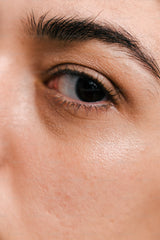Milia Seeds? We’ve a solution to remove them FAST!
Removing Milia Seeds at Meroskin
You’re doing your regular nighttime routine when you realise that your face is littered with tiny, little, white bumps. You think it’s a pimple and you try all the pimple creams hoping to clear your skin but nothing works.
Just as you are about to give up, we’re here to tell you that we have a solution!. But first, what exactly are those unsightly lumps and bumps on your face? Read On!
Milia Seeds??
Usually 1 to 2 millimetres (mm) in size, milia seeds are small, white, keratin-filled bumps that appear on the skin. They are usually 1 to 2 millimetres (mm) in size. They are bigger than whiteheads yet aren’t red and sore like pimples. They are painless but persistent and can be very difficult to get rid of.
Milia seed usually develop around the nose and eye regions causing rough and uneven skin textures but they may develop in other areas of the body as well. Milia seeds are common in babies but it is a condition that affects both men and women too.
What causes Milia Seeds
Milia seeds develop when skin flakes become trapped under the surface of the skin, or when keratin builds up and gets trapped. But what causes this in the first place?
There are a lot of factors that can cause milia seeds but the common ones are due to poor sun protection, lack of exfoliation, excessive use of soaps and cleansers, environmental pollutants, using creams that are too rich for your skin, hormonal change or damage to skin glands.
What most people don’t realise is while that rich moisturiser may be best at hydrating the skin, they also tend to be oil-based. When excessive oil accumulates and clogs up the sweat glands, milia seeds will form.
Prevention Strategies for Milia Seeds
While milia seeds cannot be completely avoided, there are various ways that can assist reduce their occurrence:

-
Gentle skincare routine: Use moderate and non-comedogenic skincare products that do not clog pores in your skincare routine. Avoid using strong lotions and oils, which might promote the production of milia seeds.
-
Sun protection: Use sunscreen with a high SPF and wear protective clothes, hats, and sunglasses to protect your skin from the damaging effects of the sun.
-
Regular exfoliation: Incorporate exfoliation into your skincare regimen on a regular basis to help eliminate dead skin cells and prevent keratin buildup.
-
Avoid picking or squeezing: plucking or squeezing milia seeds can cause skin injury and infection.
Treatment Options for Milia Seeds
While milia seeds often resolve on their own without treatment, some individuals may prefer to have them removed for cosmetic reasons. Here are several treatment options for milia seeds:
1. Extraction by a Dermatologist
Milia seeds can be removed by a dermatologist using extraction. This involves making a small incision in the skin and removing the cysts. Extraction is the most common method, but there are other options available.
2. Topical Retinoids
A dermatologist may prescribe topical retinoids, such as tretinoin, to assist exfoliate the skin and encourage the shedding of dead skin cells. This can help prevent the growth of milia seeds and enhance the overall texture of the skin.
3. Chemical Peels
Chemical peels involve the application of a chemical solution to the skin, which helps to exfoliate the top layer of dead skin cells. This can be an effective treatment option for milia seeds, as it promotes cell turnover and helps unclog pores.
4. Microdermabrasion
Microdermabrasion is a non-invasive procedure that uses a handheld device to gently exfoliate the skin. This treatment can help remove the top layer of dead skin cells, including milia seeds, revealing smoother and healthier-looking skin.
5. Cryotherapy
Cryotherapy involves the use of extreme cold temperatures to freeze and destroy the milia seeds. This treatment option is typically reserved for stubborn or recurring milia seeds and is performed by a dermatologist.
When Should You See a Dermatologist?
Milia seeds are usually safe and do not require medical attention. However, you should see a dermatologist if you have any of the following symptoms:- Milia seeds cause severe aesthetic concern or pain.
- Milia seeds remain and do not improve with time.
- You see redness, swelling, or infection surrounding the milia seeds.
At Meroskin We Have Solutions Too
In most cases, milia will disappear on their own within a few months. However, If the milia seeds on your face are irritating you, don’t pick at the affected area. Trying to remove milia can cause you to bleed, scab, and even scar.
Scraping the skin can also introduce germs to the area and cause an infection. As milia seeds don’t have a pore opening, it is best if they are treated with professional extraction techniques.
At Meroskin, we can help you remove milia seeds to help you achieve a smooth skin complexion. Our Milia Seed Removal Treatment is a painless and safe process done by our experienced and skilful aestheticians through a thorough and deep cleansing of the face to remove impurities that are present.
 >> Remove Your Milia Seeds Here <<
>> Remove Your Milia Seeds Here <<
